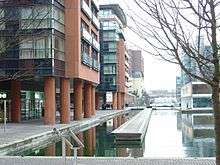Paddington Arm

The Paddington canal, or Paddington Arm of the Grand Junction Canal (later called the Grand Union) was authorised by a parliamentary Act of April 1795 which approved a 13.5-mile (22-kilometre) "navigable cut" to Paddington (in north-west London, England) from Bull's Bridge near Hayes, Hillingdon. At the time of the Industrial Revolution, the purpose was to open a water-transport route linking Paddington's light industry and western rail terminus with the industrial Midlands. It was later extended by construction of the Regents Canal which joined the River Thames at Limehouse. It also provided economical holiday travel to the countryside for urban dwellers, a function which has continued in the era of tourism. The original terminus at Paddington Basin has been conserved as a location of ambitious high-rise development.
History
The Paddington canal was opened on 10 July 1801, when 20,000 people were reported to attend, in what was then a quiet rural village. Unfortunately, the canal banks soon became a temporary dumping ground for London garbage.
Not only the dust and ashes but the filth of half London were brought to "that stinking Paddington" (as it was now called) for convenience of removal.[1]]
In later years, this nuisance was abated and many grand mansions were built alongside the banks, including Beauchamp Lodge, the home of poet Robert Browning from 1862 to 1887.[2]:p.199
References
- ↑ Robins, William (1853) Paddington Past and Present Caxton Steam Printing (1853), pp192–193
- ↑ Elrington C. R. (Editor), Baker T. F. T., Bolton D. K., Croot P. E. C. (1989) "Paddington: Westbourne Green" in A History of the County of Middlesex, Vol 9